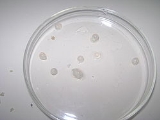
Calcium alginate
Encyclopedia
Calcium alginate is a water-insoluble, gelatinous, cream coloured substance that can be created through the addition of aqueous calcium chloride
to aqueous sodium alginate. Adding artificial flavours and colours creates a more tasty edible slime. Calcium alginate is also used for entrapment of enzymes
and forming artificial seeds in Plant tissue culture.
"Alginate" is the term usually used for the salts of alginic acid, but it can also refer to all the derivatives of alginic acid and alginic acid itself; in some publications the term "algin" is used instead of alginate. Alginate is present in the cell walls of brown algae as the calcium, magnesium and sodium salts of alginic acid.
, must be added; this holds most of the fine particles away from the surface of the filter cloth and facilitates filtration. However, filter aid is expensive and can make a significant contribution to costs. To reduce the quantity of filter aid needed, some processors force air into the extract as it is being diluted with water (the extract and diluting water are mixed in an in-line mixer into which air is forced). Fine air bubbles attach themselves to the particles of residue. The diluted extract is left standing for several hours while the air rises to the top, taking the residue particles with it. This frothy mix of air and residue is removed from the top and the solution is withdrawn from the bottom and pumped to the filter.
Calcium chloride
Calcium chloride, CaCl2, is a salt of calcium and chlorine. It behaves as a typical ionic halide, and is solid at room temperature. Common applications include brine for refrigeration plants, ice and dust control on roads, and desiccation...
to aqueous sodium alginate. Adding artificial flavours and colours creates a more tasty edible slime. Calcium alginate is also used for entrapment of enzymes
Immobilized enzyme
An immobilized enzyme is an enzyme that is attached to an inert, insoluble material such as calcium alginate . This can provide increased resistance to changes in conditions such as pH or temperature...
and forming artificial seeds in Plant tissue culture.
"Alginate" is the term usually used for the salts of alginic acid, but it can also refer to all the derivatives of alginic acid and alginic acid itself; in some publications the term "algin" is used instead of alginate. Alginate is present in the cell walls of brown algae as the calcium, magnesium and sodium salts of alginic acid.
Extraction of Alginate
To extract the alginate, the seaweed is broken into pieces and stirred with a hot solution of an alkali, usually sodium carbonate. Over a period of about two hours, the alginate dissolves as sodium alginate to give a very thick slurry. This slurry also contains the part of the seaweed that does not dissolve, mainly cellulose. This insoluble residue must be removed from the solution. The solution is too thick (viscous) to be filtered and must be diluted with a very large quantity of water. After dilution, the solution is forced through a filter cloth in a filter press. However, the pieces of undissolved residue are very fine and can quickly clog the filter cloth. Therefore, before filtration is started, a filter aid, such as diatomaceous earthDiatomaceous earth
Diatomaceous earth also known as diatomite or kieselgur/kieselguhr, is a naturally occurring, soft, siliceous sedimentary rock that is easily crumbled into a fine white to off-white powder. It has a particle size ranging from less than 1 micrometre to more than 1 millimetre, but typically 10 to...
, must be added; this holds most of the fine particles away from the surface of the filter cloth and facilitates filtration. However, filter aid is expensive and can make a significant contribution to costs. To reduce the quantity of filter aid needed, some processors force air into the extract as it is being diluted with water (the extract and diluting water are mixed in an in-line mixer into which air is forced). Fine air bubbles attach themselves to the particles of residue. The diluted extract is left standing for several hours while the air rises to the top, taking the residue particles with it. This frothy mix of air and residue is removed from the top and the solution is withdrawn from the bottom and pumped to the filter.
Preparation of Calcium alginate
The goal of the extraction process is to obtain dry, powdered, sodium alginate. The calcium and magnesium salts do not dissolve in water; the sodium salt does. The rationale behind the extraction of alginate from the seaweed is to convert all the alginate salts to the sodium salt, dissolve this in water, and remove the seaweed residue by filtration. The alginate must then be recovered from the aqueous solution. The solution is very dilute and evaporation of the water is not economic. To the Sodium alginate from the initial extraction solution, a calcium salt is added. This causes calcium alginate to form with a fibrous texture; it does not dissolve in water and can be separated from it.Uses
The uses of Calcium alginate are:- They are used in Plant tissue culture to produce insoluble artificial seeds.
- They are used for immobilizing enzymesImmobilized enzymeAn immobilized enzyme is an enzyme that is attached to an inert, insoluble material such as calcium alginate . This can provide increased resistance to changes in conditions such as pH or temperature...
by entrapment. - They can be used to produce an edible substance.
- It can be incorporated into wound dressings

